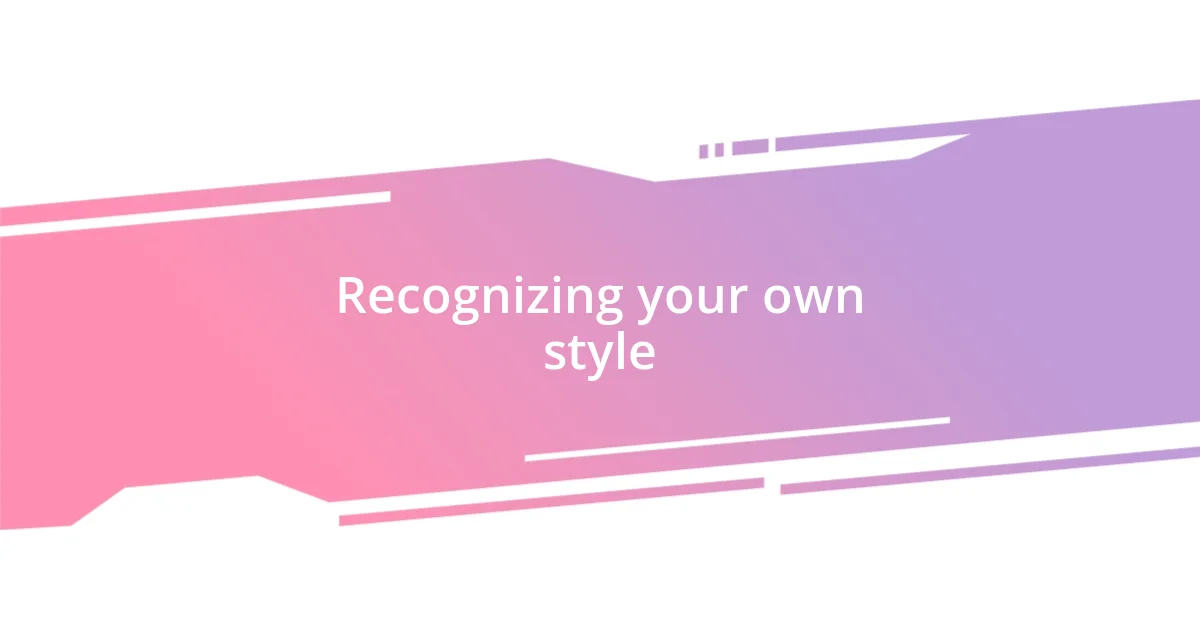Key takeaways:
- Understanding and adapting to different communication styles enhances relationships and reduces misunderstandings, fostering a more inclusive environment.
- Effective communication involves self-reflection and recognizing personal tendencies, enabling more empathetic and constructive interactions.
- Practical techniques like summarizing conversations, utilizing “I” statements, and being aware of nonverbal cues significantly improve overall communication skills.

Understanding communication styles
Understanding communication styles can be a transformative experience. I’ve often reflected on how my early interactions in group projects revealed different styles—some teammates were direct and assertive, while others were more thoughtful and reserved. Watching these dynamics unfold made me realize how vital it is to recognize and adapt to various communication preferences.
Have you ever found yourself in a conversation where you just didn’t seem to connect? I remember a time during a conflict with a friend. I was speaking in a very analytical way, while she was expressing her feelings and concerns. It struck me that without understanding her emotional communication style, I was missing the essence of her message. That experience taught me that effective communication isn’t just about what’s being said; it’s about how it’s being received.
Different communication styles can sometimes lead to misunderstandings, but they can also be an opportunity for growth. I’ve come to appreciate the diverse ways that people express themselves. For instance, I now actively listen and notice if someone uses anecdotes to share their point—this often reveals their values and priorities. This insight has not only enhanced my relationships but has also sparked my curiosity to learn more about others and their unique perspectives.

Importance of effective communication
Effective communication is fundamental in both personal and professional spheres. I’ve experienced firsthand how clear, open dialogue can prevent small misunderstandings from escalating into major conflicts. For instance, when I was leading a team project, I realized that holding regular check-ins not only clarified everyone’s tasks but also fostered a sense of trust and collaboration. This shared understanding helped the team feel more connected, and we achieved better results together.
- It enhances relationships: Effective communication promotes stronger connections with others.
- It reduces misunderstandings: Clarity in expression helps prevent conflicts or confusion.
- It boosts teamwork: Collaborative dialogue encourages participation and fun interactions.
- It increases productivity: When everyone is on the same page, tasks are completed more efficiently.
- It fosters empathy: Understanding different viewpoints cultivates respect and cooperation.
I’ve also noticed that when I actively practice empathetic communication—like nodding and affirming what others say—I create a safe space for open dialogue. I remember once having a heart-to-heart with a colleague after a tough week. By listening deeply to her struggles and sharing my own, we both left the conversation feeling lighter and more understood. Such moments reaffirm my belief that effective communication isn’t merely about words; it’s a bridge connecting people’s emotions and ideas.

Types of communication styles
Understanding the types of communication styles is crucial for effective interactions. I’ve often observed that people generally fall into categories such as assertive, passive, aggressive, and passive-aggressive. Each style carries its own strengths and weaknesses, which I’ve learned can greatly influence the outcome of conversations. For example, I once found myself in a meeting where the assertive individuals pushed their viewpoints forward confidently, while others hesitated to share their thoughts, compelling me to reflect on how differently we all approach discussions.
One memorable experience involved a friend who communicated aggressively. During a disagreement, her tone escalated, and rather than focusing on solutions, it created tension. It taught me that aggressive communication often stems from frustration or a need to control the conversation. In contrast, I observed a quiet coworker who used a passive style, often avoiding conflict altogether. Though she was easy to talk to, her reluctance to voice her opinions sometimes left valuable ideas unheard, making me realize the importance of balancing expression with receptiveness.
To truly appreciate these styles, I think it’s essential to recognize personal tendencies—and adapt accordingly. I make it a point to encourage open dialogue when I sense someone is being passive. In one situation, I asked a quieter team member for her input on our project. Her eyes lit up when she realized her ideas were valued. This reaffirmed for me that fostering diverse communication styles enriches collaboration. It’s all about creating a safe space where everyone feels heard.
| Communication Style | Description |
|---|---|
| Assertive | Confidently expresses opinions and needs while respecting others. |
| Passive | Avoids expressing feelings or opinions; often agrees to avoid conflict. |
| Aggressive | Expresses needs and desires in a forceful manner that may disrespect others. |
| Passive-Aggressive | Communicates indirectly; may appear cooperative but often harbors resentment. |

Recognizing your own style
Recognizing your own communication style begins with self-reflection. I remember a time when I got into a heated debate with a friend. As I replayed the conversation in my mind, I realized my assertiveness turned into stubbornness, overshadowing my ability to listen. Have you ever caught yourself dominating a discussion without realizing it? That moment encouraged me to consider how my style impacts not only myself but also others around me.
It can be enlightening to observe my reactions in varying situations. I’ve noticed that in conflict, I sometimes shift toward being passive-aggressive, which isn’t my intention. For instance, I found myself making subtle jabs at a coworker instead of directly addressing my frustrations. Reflecting on that experience made me question: What’s the root cause of this behavior? Understanding that it often stems from feeling unheard has motivated me to communicate more clearly and remove any indirectness from my conversations.
Ultimately, recognizing my style has been a powerful tool for growth. I strive to balance assertiveness with empathy, particularly during difficult discussions. One time, I approached a teammate with a concern, but instead of leading with criticism, I acknowledged her efforts first, which opened the door to a more constructive dialogue. Isn’t it fascinating how adjusting my approach can lead to more meaningful exchanges? Embracing this journey of self-discovery has transformed my interactions for the better.

Adapting to others’ styles
Adapting to another person’s communication style can feel like a dance; knowing when to lead and when to follow is key. I recall a colleague who often communicated in a very analytical manner, favoring facts and data over emotional appeals. At first, I struggled to connect with her. But by intentionally shifting my approach, emphasizing relevant statistics and logical reasoning in my responses, I started seeing a more collaborative interaction unfold.
There was also a situation with a friend who was naturally more passive. I realized that when I presented my arguments too strongly, she would withdraw, leaving the conversation feeling lopsided. So, I purposefully softened my approach, asking open-ended questions and allowing her space to express herself. It was eye-opening to see how this small tweak turned our discussions into engaging, two-way conversations, making her feel valued and included.
The emotional nuances are what really make adapting to others’ styles so impactful. Have you ever noticed how a gentle tone can ease tension, while a rushed communication can heighten it? In a team project, I consciously adjusted my delivery when addressing a particularly intense group member. Instead of a direct confrontation, I approached him with empathy and patience. This shift not only diffused the situation but also fostered trust. Embracing these differences teaches us to appreciate the richness in our interactions and brings us closer together.

Improving your communication skills
Improving my communication skills has been a journey filled with self-discovery and experimentation. One memorable experience was during a team meeting where I struggled to express my ideas clearly. I found myself stumbling over my words, feeling frustrated. Afterward, I reflected on the importance of preparation. Now, I take a few moments before important conversations to jot down my main points. Has anyone else felt the pressure to sound perfect? I realized that clarity often outweighs perfection.
Connecting with my emotions has also been crucial in honing my communication. There was a time I was discussing a sensitive topic with someone close to me, and I noticed my voice was tinged with frustration. I took a deep breath and shared how their behavior genuinely affected me. This shift not only made the conversation feel safer but also opened the door for a deeper connection. Feeling vulnerable doesn’t weaken us; in fact, it often strengthens our relationships. Have you ever taken that leap of vulnerability? It can be a game-changer.
Additionally, actively listening has transformed the way I communicate. I remember a situation where a friend was venting about work stress. Instead of jumping in with my own stories, I simply nodded and encouraged her to share more. What struck me was how much more I learned about her experience. Listening isn’t just about hearing words; it’s about creating a space for others to feel valued. How often do we rush to respond rather than absorb? Embracing patience in conversations often leads to richer and more meaningful interactions.

Practical tips for better communication
One practical tip that has greatly improved my communication is the art of summarizing. Recently, after a particularly lengthy meeting, I began summarizing key points before concluding. This not only reinforced everyone’s understanding but also highlighted any areas needing clarification. Have you noticed how a quick recap can shift the conversation’s momentum and keep everyone on the same page? It’s like giving your team a shared roadmap to refer back to.
Another powerful technique I swear by is using “I” statements instead of “you” statements. For instance, rather than saying, “You always interrupt me,” I would frame it as, “I feel unheard when the conversation shifts quickly.” This subtle change lowers defensiveness, paving the way for more productive discussions. Have you ever felt walls go up in conversations? I’ve found that approaching sensitive topics this way often leads to constructive dialogue rather than arguments.
Lastly, my experiences with nonverbal communication have been eye-opening. There was a time I didn’t realize how much my body language affected my conversations. During a conflict, I crossed my arms, thinking I was conveying confidence, but instead, it signaled defensiveness. I’ve since learned to maintain open gestures and consistent eye contact. How do you express openness? Your body can speak volumes even before your words do, shaping how your message is received.














